Retirement housing needs evolve considerably through three distinct phases, each requiring careful consideration of lifestyle, health, and financial factors. The Go-Go years typically demand active communities with robust amenities, while the Slow-Go phase often necessitates more supportive environments. As retirees enter the Slower-Go stage, their housing choices must prioritize accessibility and care options. Understanding these changes helps seniors make informed decisions that will impact their long-term well-being and independence.
Key Takeaways
- Go-Go Phase residents thrive in independent living communities with amenities, often choosing to downsize while maintaining an active, social lifestyle.
- Slow-Go Phase requires assisted living facilities or CCRCs, incorporating home modifications and accessibility features for changing physical needs.
- Slower-Go Phase demands specialized care facilities with memory care or skilled nursing support for comprehensive medical and daily assistance.
- Middle housing options like townhouses offer cost-effective alternatives, typically 30% cheaper than single-family homes while maintaining community engagement.
- Early planning and flexible housing strategies across all phases ensure smooth transitions and sustainable living arrangements throughout retirement.
Understanding the Three Stages of Retirement Living
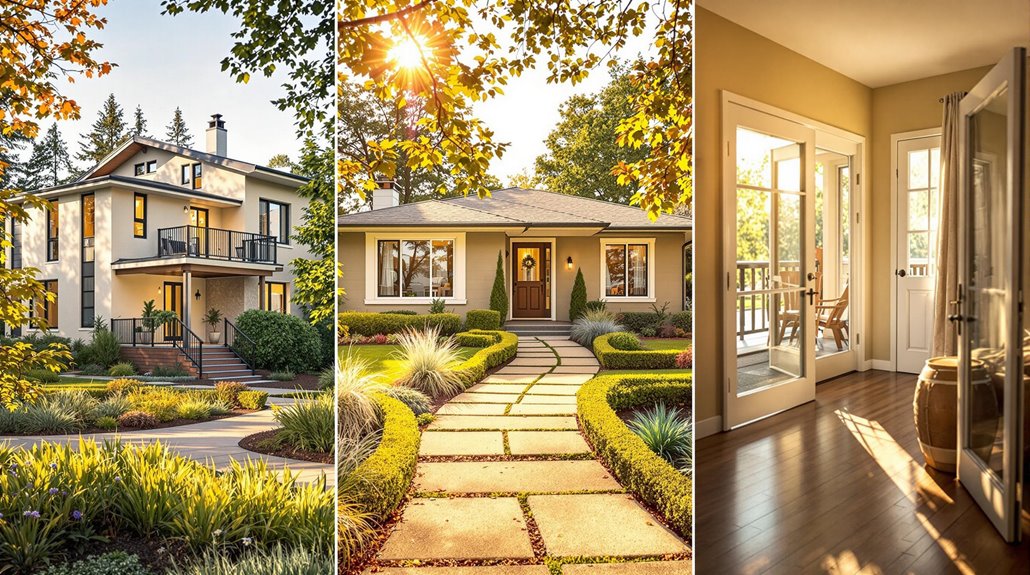
As seniors progress through their retirement years, they typically experience three distinct phases of living that correspond to different housing needs and levels of care.
During the initial “go-go” phase, active engagement characterizes lifestyle preferences, making independent living communities and age-friendly developments ideal choices.
The “slow-go” phase often necessitates shifting to assisted living facilities or CCRCs, where personalized care plans support changing needs while maintaining independence.
Finally, the “slower-go” phase may require specialized memory care or skilled nursing support, particularly for those facing cognitive decline.
Understanding these phases helps families and seniors make informed decisions about housing options, ensuring appropriate care levels and amenities align with each stage’s unique requirements.
Strategic Housing Choices During the Go-Go Years
When retirees enter their “go-go” years, strategic housing decisions become paramount for maintaining financial stability and lifestyle preferences throughout retirement. During this active phase, many Baby Boomers and Gen X homeowners evaluate properties that balance urban amenities with flexible living spaces.
Nearly 28% plan to downsize within five years, often seeking locations closer to family while preserving home equity for future needs.
For those pursuing an active lifestyle, community-centric properties with amenities gain popularity, particularly in small towns and rural areas offering affordability and accessibility.
Financial planning integrates housing decisions with retirement portfolios, as 60% of older homeowners align their housing strategy with thorough retirement plans.
This approach helps guarantee sustainable income streams while maintaining the flexibility to adapt to changing circumstances.
Adapting Your Living Space in the Slow-Go Phase
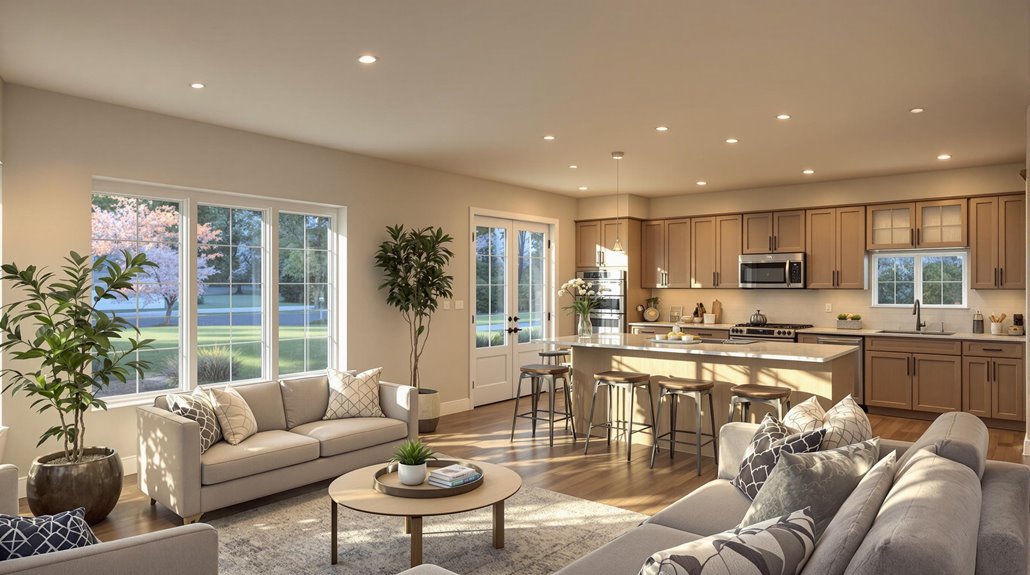
The slow-go phase of retirement brings new considerations for modifying living spaces to support changing physical needs and lifestyle patterns.
Research demonstrates that early implementation of home modifications and accessibility features greatly impacts long-term health outcomes while maintaining independence.
Strategic planning helps balance costs with evolving requirements, ensuring adaptations align with healthcare recommendations.
Key considerations for successful home modifications include:
- Prioritizing preventive adaptations that slow disability progression
- Implementing changes in phases to manage expenses effectively
- Partnering with local authorities for proper installation guidance
- Using assessment tools to predict future accessibility requirements
These proactive modifications help seniors maintain quality of life while addressing potential challenges before they become urgent, resulting in more cost-effective solutions and better health outcomes over time.
Housing Solutions for the Slower-Go Period
During retirement’s slower-go period, middle housing options have emerged as increasingly essential solutions for seniors seeking to balance independence with accessibility.
Townhouses and courtyard apartments offer affordable housing alternatives, typically costing 30% less than traditional single-family homes while maintaining community engagement through shared spaces and amenities.
Middle housing provides an economical path to homeownership while fostering social connections through intentionally designed community spaces.
Cities across the Sun Belt and Mountain West regions have successfully implemented these housing solutions through innovative zoning reforms and streamlined approval processes.
Communities like Sandy, UT, and San Marcos, CA, demonstrate how transit-oriented development and strategic urban infill can create vibrant neighborhoods that support aging residents.
Municipal programs further enhance accessibility through targeted grants and land donations, ensuring seniors can maintain their autonomy while accessing necessary support services within walkable distances.
Financial Planning for Each Stage’s Housing Needs
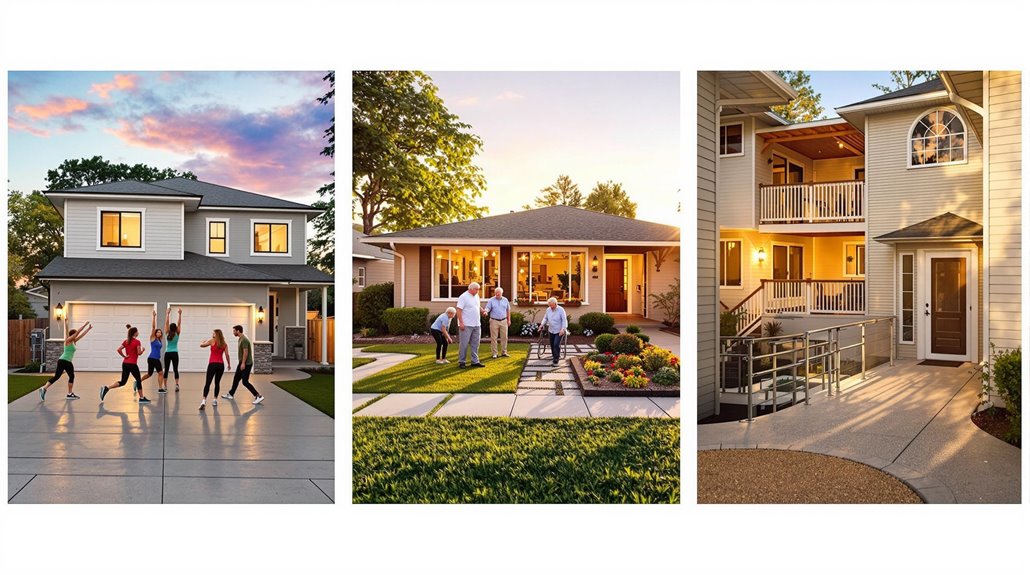
Strategic financial preparation underpins successful housing choices throughout life’s major stages, from early career through retirement years. Understanding and implementing sound financial literacy principles enables individuals to make informed decisions about housing investments that align with their life phase and future needs.
- Building a strong foundation in early career years through emergency funds and credit management.
- Maximizing investment potential during peak earning years through diversified portfolios and tax strategies.
- Optimizing pre-retirement planning with strategic downsizing and senior living research.
- Managing retirement assets effectively to support housing shifts and care needs.
This all-encompassing approach guarantees adequate resources for evolving housing requirements, from first-time homeownership through retirement communities, while maintaining financial stability and independence throughout each life stage.
Market Considerations Across Retirement Phases
Market dynamics greatly influence housing decisions across retirement phases, requiring careful consideration of regional trends, inventory levels, and affordability factors.
Current market trends indicate stronger opportunities in the Midwest and Northeast, where limited inventory supports price stability. These regions offer promising retirement housing options, particularly in suburban and rural areas where affordability issues are less severe.
Limited housing inventory in the Midwest and Northeast creates stable markets, with suburban and rural areas offering attractive options for retirees.
Investment opportunities vary markedly across regions, with Southern markets experiencing price adjustments due to increasing inventory.
Buyer preferences continue shifting toward areas offering space and community amenities, particularly relevant for retirees in different phases. Understanding these regional disparities becomes vital when planning housing changes, as markets with high new-home inventories may present negotiating advantages, while areas with limited existing homes require more strategic timing.
Evaluating Community and Lifestyle Requirements
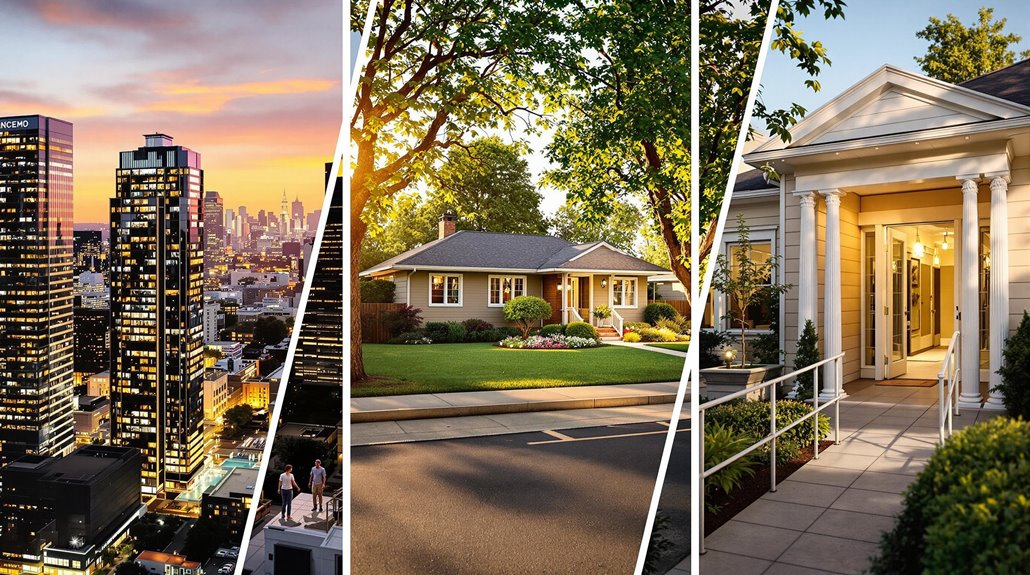
As retirees navigate different phases of their later years, evaluating community and lifestyle requirements becomes increasingly critical for maintaining quality of life and independence.
The shift through retirement stages demands careful consideration of housing options that support evolving needs while fostering community engagement and lifestyle flexibility.
- Active adults typically seek independent living communities with robust amenities, including fitness centers and social programs.
- Those entering the slow-go phase prioritize locations with accessible healthcare and daily living assistance.
- High-need seniors benefit from communities offering integrated medical services and memory care support.
- Across all phases, smaller communities of 100 units or fewer consistently demonstrate higher satisfaction rates due to personalized attention and stronger social connections.
Making the Transition Between Stages Seamless
Moving between different housing arrangements during retirement requires careful coordination of financial resources, support systems, and timing to guarantee a smooth progression through life’s later chapters.
To facilitate seamless shifts, organizations must develop extensive funding strategies that bridge operational gaps while maintaining essential services. This includes establishing partnerships with housing authorities, coordinating with local service providers, and leveraging various subsidy programs to guarantee housing flexibility.
Success depends on thorough advance planning, from creating individualized shift timelines to implementing standardized procedures for housing transfers. Organizations should also focus on securing sustainable funding sources, including private philanthropy and government grants, while maintaining strong relationships with community partners who can provide ongoing support through each stage of senior housing.
Bottom Line
Successful retirement housing changes require careful planning and consideration of evolving needs across the three distinct phases. By understanding the unique requirements of each stage and making informed decisions about housing options, retirees can maintain independence, receive appropriate care, and preserve financial stability. Strategic planning, combined with regular assessment of living arrangements, guarantees seniors can age comfortably while maintaining their desired quality of life throughout retirement.
